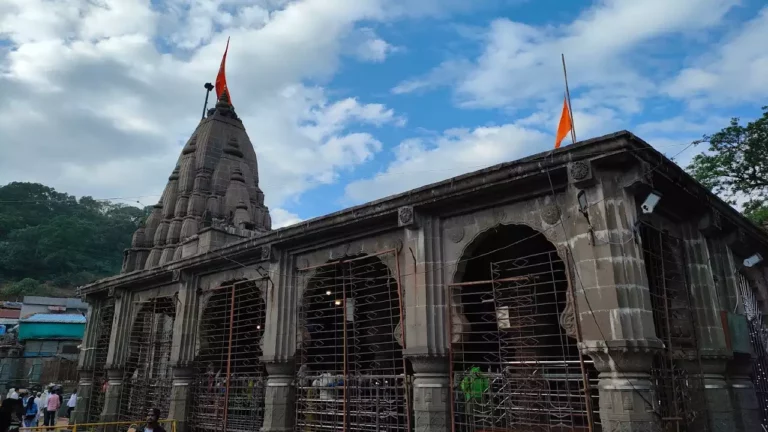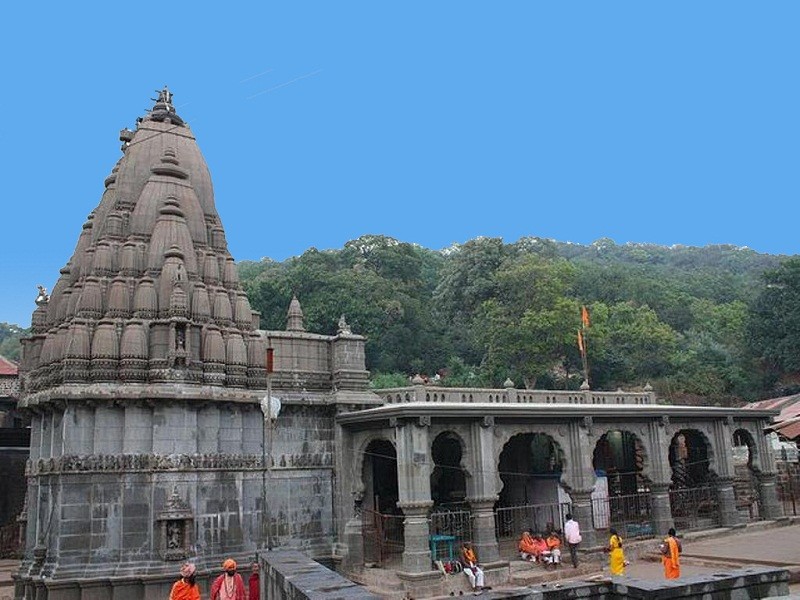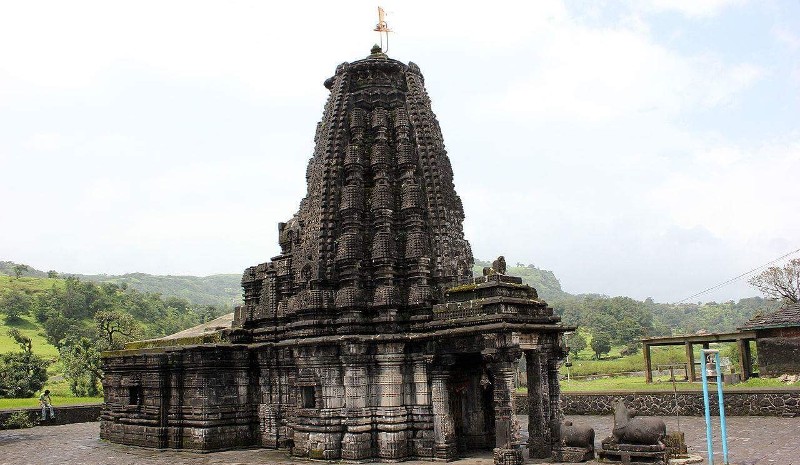The Bhimashankar Temple is a prominent Hindu temple located in the Sahyadri hills of Maharashtra, India. It is one of the twelve Jyotirlingas, which are considered to be the most sacred abodes of Lord Shiva. The temple holds great religious and historical significance in Hinduism.The temple is situated in the village of Bhorgiri in the Pune district of Maharashtra and is surrounded by the scenic Bhimashankar Wildlife Sanctuary.
Key features of the Bhimashankar Temple:
-
Jyotirlinga: The primary attraction of the temple is the Lingam (an iconic representation of Lord Shiva) known as Bhimashankar Jyotirlinga. It is considered one of the most powerful manifestations of Lord Shiva.
-
Architectural Style: The temple showcases traditional Nagara style architecture with beautiful carvings and sculptures. It is built from black stone and is adorned with intricate designs.
-
Location: The temple is located in the Sahyadri range of the Western Ghats and offers a serene and picturesque setting. It’s a popular pilgrimage destination and a place of natural beauty.
-
Bhimashankar Wildlife Sanctuary: The temple is located within the Bhimashankar Wildlife Sanctuary, which is home to a variety of flora and fauna, including several rare and endangered species. The sanctuary is a part of the Western Ghats, a UNESCO World Heritage site.
-
Religious Significance: Bhimashankar Temple holds significant religious importance for Shiva devotees. It is said to be the place where Lord Shiva is believed to have slain the demon Tripurasura. The temple attracts a large number of pilgrims, particularly during the Mahashivratri festival.
-
Pilgrimage: Devotees often visit the temple as part of the Ashtavinayak pilgrimage, a circuit of eight significant Ganesha temples in the state of Maharashtra.
-
Festivals: Various Hindu festivals are celebrated at the Bhimashankar Temple, with Mahashivratri being the most prominent. During Mahashivratri, the temple sees a large gathering of devotees who come to seek Lord Shiva’s blessings.
-
Trekking: Besides its religious significance, Bhimashankar is also known for trekking and adventure activities. The trekking trails in the surrounding forested area are popular among nature enthusiasts.
Visiting the Bhimashankar Temple provides not only a spiritual experience but also an opportunity to connect with nature in a lush and serene environment. It is an important religious and ecological landmark in Maharashtra, offering a blend of spirituality and natural beauty.
Table of Content
History
Bhimashankar Temple is a significant Hindu temple located in the Sahyadri hills of Maharashtra, India. It is one of the 12 Jyotirlingas, which are considered to be the most sacred abodes of Lord Shiva. The temple has a rich history and is associated with various legends and mythological stories. Here’s a brief overview of the history and significance of Bhimashankar Temple:
- Mythological History:
- According to Hindu mythology, Bhimashankar Temple is associated with the demon Tripurasura. It is believed that the demon caused havoc and created three formidable forts in the sky, collectively known as the “Tripura.” Lord Shiva, upon the request of the gods, took the form of a gigantic and fierce warrior, Bhima, and destroyed the forts with his divine power. Hence, the temple is named Bhimashankar in honor of this manifestation of Shiva.
- Historical Significance:
- The temple’s history can be traced back to ancient times, and it has undergone various renovations and reconstructions over the centuries.
- Chhatrapati Shivaji Maharaj, the great Maratha warrior king, is believed to have made significant contributions to the temple’s restoration and development.
- The architecture of the temple reflects the traditional Nagara style, characterized by intricately carved stone structures and sculptures.
- Location:
- Bhimashankar Temple is situated in the Western Ghats of Maharashtra, in the Pune district. The temple is surrounded by lush green forests and offers a serene and picturesque setting.
- Festivals and Celebrations:
- The temple is a popular pilgrimage site and sees a large number of devotees, especially during the festival of Maha Shivaratri. This annual festival dedicated to Lord Shiva is celebrated with great enthusiasm at Bhimashankar Temple.
- Jyotirlinga Status:
- Bhimashankar is one of the 12 Jyotirlingas, which are considered to be the most sacred shrines dedicated to Lord Shiva. These 12 Jyotirlingas are spread across India and are revered by millions of Shiva devotees.
Bhimashankar Temple, with its historical and mythological significance, natural beauty, and religious importance, continues to be a revered place of worship and a popular destination for pilgrims and tourists alike.
Yearly Festivals
Bhimashankar Temple is one of the 12 Jyotirlingas (shrines dedicated to Lord Shiva) located in India. The temple, situated in the Sahyadri range of the Western Ghats in the state of Maharashtra, is a significant pilgrimage site. While I don’t have access to real-time data or specific schedules, I can provide you with some information about the general yearly pujas and festivals that are typically celebrated at Bhimashankar Temple:
- Maha Shivaratri: Maha Shivaratri is one of the most important festivals at Bhimashankar Temple and is celebrated with great enthusiasm. Devotees observe a night-long vigil, perform special pujas, and offer prayers to Lord Shiva.
- Rudrabhishek: This is a regular and important ritual where the Shiva Linga is bathed with holy water, milk, ghee, honey, and other sacred substances while chanting Vedic mantras. This puja is believed to bring blessings and remove obstacles from one’s life.
- Pradosh Vrat: Pradosh Vrat is observed on the 13th day of both the lunar fortnights and is dedicated to Lord Shiva. Special pujas and prayers are offered on this day.
- Shravan Month: The holy month of Shravan, usually falling in July or August, is considered highly auspicious for Lord Shiva. Devotees visit the temple in large numbers during this period, offer milk and perform abhishek to the Shiva Linga.
- Bhimashankar Jayanti: The temple celebrates the Jayanti or birth anniversary of Lord Shiva in a grand manner.
- Navratri: During the Navratri festival, especially in the months of Chaitra and Ashwin, there may be special pujas and celebrations at the temple.
- Other Festivals: Other Hindu festivals like Gudi Padwa, Diwali, and Holi may also be celebrated at the Bhimashankar Temple with special pujas and rituals.
Please note that the schedule and specific pujas may vary from year to year, and it’s advisable to check with the temple authorities or a local source for the most up-to-date information on the yearly pujas and festivals at Bhimashankar Temple.
Daily Pujas
The Bhimashankar Temple is a Jyotirlinga shrine dedicated to Lord Shiva located in the Pune district of the Indian state of Maharashtra. The temple conducts various daily rituals and pujas to worship Lord Shiva. While the specific details of daily pujas may vary, a typical day at the Bhimashankar Temple may include the following:
-
Mangal Aarti: The day at the temple usually begins with the Mangal Aarti, which is performed early in the morning before sunrise. Devotees gather to witness this sacred ritual, where lamps are lit, and hymns are sung in praise of Lord Shiva.
-
Abhishek: Abhishek is the ceremonial bathing of the Shiva Lingam with sacred water, milk, ghee, and other offerings. This is usually done several times throughout the day, with different types of liquids.
-
Rudrabhishek: This is a special puja that involves the chanting of the Rudra mantra and is dedicated to Lord Shiva in his fierce form. It is performed with great devotion.
-
Dhoop Aarti: The Dhoop Aarti is conducted in the temple during the morning hours. Incense sticks and other offerings are made to the deity during this ritual.
-
Maha Nivedana: The main offering or meal of the day is prepared and offered to the deity, and then it is distributed as prasadam to the devotees.
-
Naivedya Aarti: This is a ritual where various food items, fruits, and sweets are offered to the deity, symbolizing the sharing of a meal with the Lord.
-
Bhog Aarti: Another aarti is performed in the afternoon, often followed by the distribution of prasadam to devotees.
-
Sheja Aarti: This is the evening aarti that marks the end of the temple’s daily worship routine. It is a serene and spiritually uplifting ceremony.
-
Shringar Aarti: The Shringar Aarti is performed before the temple doors are closed for the night. It involves decorating the deity with jewelry and beautiful garments.
-
Shayana Aarti: This is the final aarti of the day, performed to mark the time when Lord Shiva retires for the night.
Please note that the timing and details of these pujas may vary from one temple to another, and it’s a good idea to check with the specific Bhimashankar Temple for the most accurate and up-to-date information on their daily rituals and schedule.
How To Reach
Bhimashankar Temple is a famous Hindu temple located in the Sahyadri hills of Maharashtra, India. It is one of the 12 Jyotirlingas dedicated to Lord Shiva. To reach Bhimashankar Temple, you can follow these general directions:
By Road:
- From Pune: Bhimashankar is approximately 110 kilometers away from Pune. You can start your journey from Pune and drive towards Bhimashankar. The drive takes around 4-5 hours depending on traffic conditions. You can take the following route:
- Pune > Pimpri Chinchwad > Talegaon > Chakan > Rajgurunagar > Bhimashankar
- From Mumbai: If you are coming from Mumbai, the distance is approximately 210 kilometers, and the journey can take around 5-6 hours. The route typically involves the following:
- Mumbai > Panvel > Khalapur > Khopoli > Lonavala > Bhimashankar
Please note that road conditions may vary, and it’s a good idea to check with local authorities for any updates on the road conditions, especially during the monsoon season when some roads may be inaccessible.
By Bus: Several private and state-run buses operate between Pune and Bhimashankar. You can check with local bus operators or use online bus booking platforms to find a suitable bus service.
By Train: The nearest railway station to Bhimashankar is Pune Railway Station. From Pune, you can hire a taxi or take a bus to reach Bhimashankar.
By Air: The nearest airport is Pune International Airport. From the airport, you can either hire a taxi or take a bus to reach Bhimashankar.
Please keep in mind that the road conditions and routes may change, so it’s advisable to check with local sources for the most up-to-date information on how to reach Bhimashankar Temple before you plan your trip. Additionally, it’s a good idea to ensure that the temple is open for visitors on the day you plan to visit, and to be aware of any local customs and guidelines for visiting the temple.
Where To Stay
Bhimashankar Temple is a famous Hindu temple dedicated to Lord Shiva and is located in the Sahyadri Hills of Maharashtra, India. If you’re looking for places to stay near Bhimashankar Temple, there are a few options to consider:
-
Bhimashankar Temple Guesthouses: The temple trust often provides guesthouses or accommodations for pilgrims and visitors. These are typically affordable and convenient options for those who wish to stay close to the temple.
-
Bhimashankar Wildlife Sanctuary: The temple is located within the Bhimashankar Wildlife Sanctuary. You can find some eco-friendly resorts and lodges in the sanctuary for a more immersive experience in nature.
-
Manchar: Manchar is a nearby town where you can find a variety of budget and mid-range hotels. It’s about 40 kilometers from Bhimashankar Temple.
-
Rajgurunagar (Khed): Another option is to stay in Rajgurunagar, which is about 50 kilometers from the temple. There are a few accommodation options in this town.
-
Pune: If you prefer a wider range of hotels and amenities, you can stay in Pune, which is about 100 kilometers from Bhimashankar Temple. Pune offers a variety of accommodations to suit different budgets.
-
Online Booking Platforms: You can also check online booking platforms like Booking.com, MakeMyTrip, or Airbnb for accommodations near Bhimashankar Temple. These platforms often have a wide range of options, including hotels, guesthouses, and homestays.
Make sure to book your accommodation in advance, especially during peak pilgrimage seasons, as Bhimashankar Temple can get crowded. Additionally, check for the latest information and reviews to ensure you choose the best accommodation that suits your needs.




